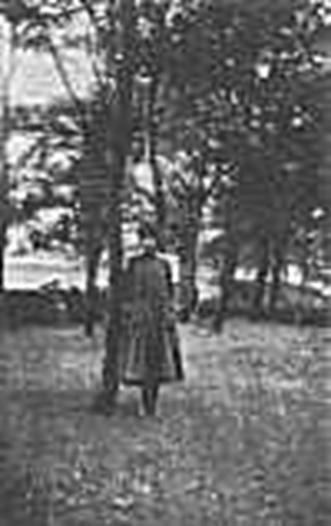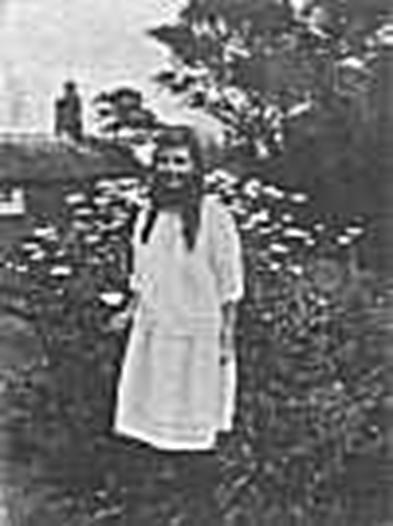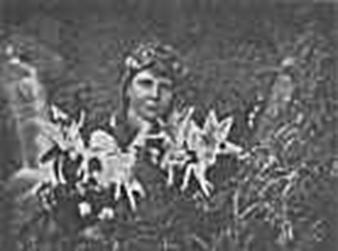Delphi Complete Works of Sir Arthur Conan Doyle (Illustrated) (1478 page)
Read Delphi Complete Works of Sir Arthur Conan Doyle (Illustrated) Online
Authors: SIR ARTHUR CONAN DOYLE

4. My report is enclosed and you are at perfect liberty to use this just as you please.
The father, Mr. Arthur Wright, impressed me favourably. He was perfectly open and free about the whole matter. He explained his position — he simply did not understand the business, but is quite clear and positive that the plate he took out of the Midg camera was the one he put in the same day. His work is that of electrician to an estate in the neighbourhood near. He is clear-headed and very intelligent, and gives one the impression of being open and honest. I learnt the reason of the family’s cordial treatment of myself. Mrs. Wright, a few years back, came into touch with theosophical teachings and speaks of these as having done her good. My own connection with the Theosophical Society she knew of and this gave them confidence. Hence the very cordial reception I have met with, which somewhat had puzzled me.
By the way, I think “L. W’ guide ran up against innocent little Snelling! He matches the description quite well, as I realised last night. And he did prepare the new negatives from which the prints you have were made, and he has a room full up with weird machines with handles and devices used in photography. . . .
Sincerely yours,
EDW. L. GARDNER.
I trust that the reader will agree that up to this point we had not proceeded with any undue rashness or credulity, and that we had taken all common-sense steps to test the case, and had no alternative, if we were unprejudiced seekers for truth, but to go ahead with it, and place our results before the public, so that others might discover the fallacy which we had failed to find. I must apologize if some of the ground in the
Strand
article which follows has already been covered in this introductory chapter.
THE FIRST PUBLISHED ACCOUNT—”STRAND” CHRISTMAS NUMBER, 192
0
Should the incidents here narrated, and the photographs attached, hold their own against the criticism which they will excite, it is no exaggeration to say that they will mark an epoch in human thought. I put them and all the evidence before the public for examination and judgment. If I am myself asked whether I consider the case to be absolutely and finally proved, I should answer that in order to remove the last faint shadow of doubt I should wish to see the result repeated before a disinterested witness. At the same time, I recognise the difficulty of such a request, since rare results must be obtained when and how they can. But short of final and absolute proof, I consider, after carefully going into every possible source of error, that a strong
prima-facie
case has been built up. The cry of “fake” is sure to be raised, and will make some impression upon those who have not had the opportunity of knowing the people concerned, or the place. On the photographic side every objection has been considered and adequately met. The pictures stand or fall together. Both are false, or both are true. All the circumstances point to the latter alternative, and yet in a matter involving so tremendous a new departure one needs overpowering evidence before one can say that there is no conceivable loophole for error.
It was about the month of May in this year that I received the information from Miss Felicia Scatcherd, so well known in several departments of human thought, to the effect that two photographs of fairies had been taken in the North of England under circumstances which seemed to put fraud out of the question. The statement would have appealed to me at any time, but I happened at the moment to be collecting material for an article on fairies, now completed, and I had accumulated a surprising number of cases of people who claimed to be able to see these little creatures. The evidence was so complete and detailed, with such good names attached to it, that it was difficult to believe that it was false; but, being by nature of a somewhat sceptical turn, I felt that something closer was needed before I could feel personal conviction and assure myself that these were not thought-forms conjured up by the imagination or expectation of the seers. The rumour of the photographs interested me deeply, therefore, and following the matter up from one lady informant to another, I came at last upon Mr. Edward L. Gardner, who has been ever since my most efficient collaborator, to whom all credit is due. Mr. Gardner, it may be remarked, is a member of the Executive Committee of the Theosophical Society, and a well-known lecturer upon occult subjects.
He had not himself at that time mastered the whole case, but all he had he placed freely at my disposal. I had already seen prints of the photographs, but I was relieved to find that he had the actual negatives, and that it was from them, and not from the prints, that two expert photographers, especially Mr. Snelling of 26 The Bridge, Wealdstone, Harrow, had already formed their conclusions in favour of the genuineness of the pictures. Mr. Gardner tells his own story presently, so I will simply say that at that period he had got into direct and friendly touch with the Carpenter family. We are compelled to use a pseudonym and to withhold the exact address, for it is clear that their lives would be much interrupted by correspondence and callers if their identity were too clearly indicated. At the same time there would be, no doubt, no objection to any small committee of inquiry verifying the facts for themselves if this anonymity were respected. For the present, however, we shall simply call them the Carpenter family in the village of Dalesby, West Riding.
Some three years before, according to our information, the daughter and the niece of Mr. Carpenter, the former being sixteen and the other ten years of age, had taken the two photographs — the one in summer, the other in early autumn. The father was quite agnostic in the matter, but as his daughter claimed that she and her cousin when they were together continually saw fairies in the wood and had come to be on familiar and friendly terms with them, he entrusted her with one plate in his camera. The result was the picture of the dancing elves, which considerably amazed the father when he developed the film that evening. The little girl looking across at her playmate, to intimate that the time had come to press the button, is Alice, the niece, while the older girl, who was taken some months later with the quaint gnome, is Iris, the daughter. The story ran that the girls were so excited in the evening that one pressed her way into the small dark-room in which the father was about to develop, and that as she saw the forms of the fairies showing through the solution she cried out to the other girl, who was palpitating outside the door: “Oh, Alice, Alice, the fairies are on the plate — they are on the plate!” It was indeed a triumph for the children, who had been smiled at, as so many children are smiled at by an incredulous world for stating what their own senses have actually recorded.
The father holds a position of trust in connection with some local factory, and the family are well known and respected. That they are cultivated is shown by the fact that Mr. Gardner’s advances towards them were made more easy because Mrs. Carpenter was a reader of theosophical teachings and had gained spiritual good from them. A correspondence had arisen and all their letters were frank and honest, professing some amazement at the stir which the affair seemed likely to produce.
Thus the matter stood after my meeting with Mr. Gardner, but it was clear that this was not enough. We must get closer to the facts. The negatives were taken round to Kodak, Ltd., where two experts were unable to find any flaw, but refused to testify to the genuineness of them, in view of some possible trap. An amateur photographer of experience refused to accept them on the ground of the elaborate and Parisian coiffure of the little ladies. Another photographic company, which it would be cruel to name, declared that the background consisted of theatrical properties, and that therefore the picture was a worthless fake. I leaned heavily upon Mr. Snelling’s wholehearted endorsement, quoted later in this article, and also consoled myself by the broad view that if the local conditions were as reported, which we proposed to test, then it was surely impossible that a little village with an amateur photographer could have the plant and the skill to turn out a fake which could not be detected by the best experts in London.
The matter being in this state, Mr. Gardner volunteered to go up at once and report — an expedition which I should have wished to share had it not been for the pressure of work before my approaching departure for Australia. Mr. Gardner’s report is here appended:
5
Craven Road, Harlesden, N.W
. 10,
July
29, 1920.
It was early in this year, 1920, that I heard from a friend of photographs of fairies having been successfully taken in the [paragraph continues] North of England. I made some inquiries, and these led to prints being sent to me with the names and address of the children who were said to have taken them. The correspondence that followed seemed so innocent and promising that I begged the loan of the actual negatives — and two quarter-plates came by post a few days after. One was a fairly clear one, the other much underexposed.
The negatives proved to be truly astonishing photographs indeed, for there was no sign of double exposure nor anything other than ordinary straightforward work. I cycled over to Harrow to consult an expert photographer of thirty years’ practical experience whom I knew I could trust for a sound opinion. Without any explanation I passed the plates over and asked what he thought of them. After examining the “fairies” negative carefully, exclamations began: “This is the most extraordinary thing I’ve ever seen!” “Single exposure!” “Figures have moved!” “Why, it’s a genuine photograph! Wherever did it come from?” I need hardly add that enlargements were made and subjected to searching examination — without any modification of opinion. The immediate upshot was that a “positive” was taken from each negative, that the originals might be preserved carefully untouched, and then new negatives were prepared and intensified to serve as better printing mediums. The originals are just as received and in my keeping now. Some good prints and lantern slides were soon prepared.
In May I used the slides, with others, to illustrate a lecture given in the Mortimer Hall, London, and this aroused considerable interest, largely because of these pictures and their story. A week or so later I received a letter from Sir A. Conan Doyle asking for information concerning them, some report, I understood, having reached him from a mutual friend. A meeting with Sir Arthur followed, and the outcome was that I agreed to hasten my proposed personal investigation into the origin of the photographs, and carry this through at once instead of waiting till September, when I should be in the North on other matters.
In consequence, to-day, July 29, I am just back in London from one of the most interesting and surprising excursions that it has ever been my fortune to make!
We had time, before I went, to obtain opinions on the original negatives from other expert photographers, and one or two of these were adverse rather than favourable. Not that any would say positively that the photographs were faked, but two did claim that they could produce the same class of negative by studio work involving painted models, etc., and it was suggested further that the little girl in the first picture was standing behind a table heaped up with fern and moss, that the toad-stool was unnatural, that in the gnome photo the girl’s hand was not her own, that uniform shading was questionable, and so on. All of this had its weight, and though I went North with as little bias one way or the other as possible, I felt quite prepared to find that a personal investigation would disclose some evidence of falsity.
The lengthy journey completed, I reached

ELSIE IN 1920, STANDING NEAR WHERE THE GNOME WAS TAKEN IN 1917

FRANCES IN 1920

A. FRANCES AND THE FAIRIES
Photograph taken by Elsie. Bright sunny day in July, 1917. The “Midg” camera. Distance,
